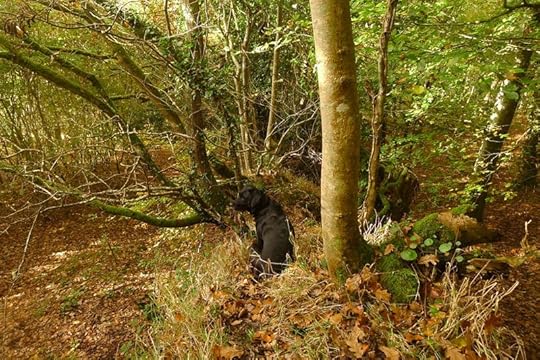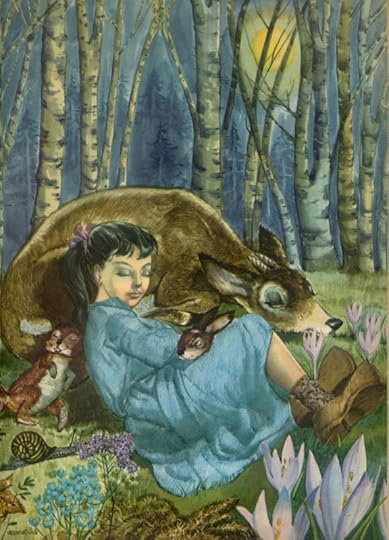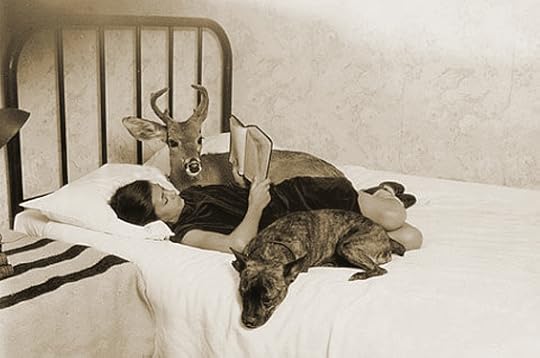Terri Windling's Blog, page 125
November 15, 2015
Myth & Moor update
Dear Readers,
Well, so much for plans. I'd scheduled an off-line Work Retreat for last week, my intent being to catch up on all the writing and correspondence that I've fallen behind on due to health problems over the summer. I'd been planning this Retreat since September (postponed several time), so I woke up early Monday morning excited and eager to begin at long last...and within an hour I was back in bed again, knocked off my feet by the latest lurgy (a virulent cold-flu combo) making the rounds of our village.
"It's just not fair!" I wailed to my patient husband...or, rather, croaked to him, since by this time my voice was disappearing rapidly. I'd barely left the house for many months precisely to avoid catching anything like this while in a weakened state of health -- but the week before I'd finally reached a level of recovery where I could start to live a more normal life. I went out exactly twice that week: to dinner at a friend's house and to a Sam Lee* concert at a small local venue...and, alas, that's all it took to put me back in bed again.
All of which is to say that I don't know when Myth & Moor will resume...it depends on how long this lurgy lasts. I've barely been able to read this week, let alone write; I can only hope the coming week will be kinder.
Also, I send my deepest apologies to those of you awaiting for correspondence from me; I will get to it as soon as I possibly can, and I'm grateful for your continued patience.
Finally, to the Video Fairies (you know who you are) who have been showering me with videos out of the blue: your timing couldn't have been better, and I'm touched indeed. More personalized thanks will be coming your way as soon as energy permits, and I love you all.
 * If you ever have a chance to see Sam Lee perform live, please don't miss it. He's incredible. Art above: Sleeping Beauty by Honor Appleton (1879-1951).
* If you ever have a chance to see Sam Lee perform live, please don't miss it. He's incredible. Art above: Sleeping Beauty by Honor Appleton (1879-1951).
November 7, 2015
Myth & Moor update
Dear Readers: I'm taking a week's Off-line Retreat in order to catch up on work (heath issues have been hell on my schedule), and also because it's good to disconnect from the web periodically.
Tilly and I will be back on Monday the 17th. Have a good, wild, and wildly creative week.
November 5, 2015
Dreams of deer
I have another deer poem for you today, a psalm for the wild ones of the forest.
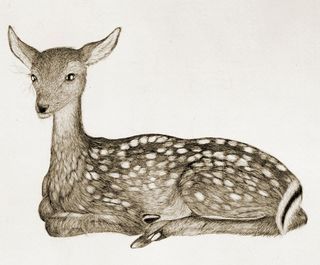 The enchanted deer in the pictures above and below come from two classic French fairy volumes. Above is "Brother and Sister" from Les contes de Grimm, illustrated by Cremonini (Editions Fabbri, 1965). Below is "Bright, Dear Deer, and Kit" from Le livre des b��tes enchant��es, illustrated by Adrienne S��gur (Flammarion, 1956). Selections from Le livre des b��tes enchant��es and an earlier volume, Il ��tait une fois, were published in the U.S. as The Golden Book of Fairy Tales, translated by Marie Ponsot (Golden Books, 1958).
The enchanted deer in the pictures above and below come from two classic French fairy volumes. Above is "Brother and Sister" from Les contes de Grimm, illustrated by Cremonini (Editions Fabbri, 1965). Below is "Bright, Dear Deer, and Kit" from Le livre des b��tes enchant��es, illustrated by Adrienne S��gur (Flammarion, 1956). Selections from Le livre des b��tes enchant��es and an earlier volume, Il ��tait une fois, were published in the U.S. as The Golden Book of Fairy Tales, translated by Marie Ponsot (Golden Books, 1958).
The illustration on the right is "Fawn," by the German-American artist Kiki Smith. Alas, I have no idea where the final photograph is from...but isn't it marvelous?
Boredom in the studio...
Not my boredom; I've got too much to do to be bored. But Tilly is on antibiotics for a persistent infection and can't go out into the woods today. She's been listless and miserable all morning...until a new bone made life worth living again. Now everything is wonderful, misery forgotten.
I want to be a dog in my next life.
November 4, 2015
This is sacred work
From "O.K., You're Not Shakespeare. Now Get Back to Work," an excellent essay by Allegra Goodman:
"Treat writing as a sacred act. Just as the inner critic loves to dwell on the past, she delights in worrying about the future. 'Who would want to read this?' she demands. 'Nobody is going to publish a book like that!' Such nagging can incapacitate unpublished writers. Published writers, on the other hand, know that terrible books come out all the time. They anguish: 'The reviewers are going to crucify me, and nobody will want to publish me after that.'
"But take a step back. What are you really afraid of here? When you come down to it, this is just a case of the inner critic masquerading as public opinion, and playing on your vanity.
"I know only one way out of this trap, which is to concentrate on your writing itself, for itself. Figuring out what the public wants, or even what the public is: that's the job of pollsters and publicists and advertisers. All those people study the marketplace. But the creative artist can change the world. A true writer opens people's ears and eyes, not merely playing to the public, but changing minds and lives. This is sacred work.
"Love your material. Nothing frightens the inner critic more than the writer who loves her work. The writer who is enamored of her material forgets all about censoring herself. She doesn't stop to wonder if her book is any good, or who will publish it, or what people will think. She writes in a trance, losing track of time, hearing only her characters in her head.
"This is a state of grace possible only when you are truly desperate to tell a story."
 Words: The essay quoted above was first published in The New York Times (March 12, 2001), and is well worth reading in full. The poem in the picture captions is from Wake Up in Brightness (Poetry in the Schools, Seattle 2009). All rights reserved by the authors. A related post: "When Every Day is Judgement Day." Pictures: A walk on the village Commons earlier this week.
Words: The essay quoted above was first published in The New York Times (March 12, 2001), and is well worth reading in full. The poem in the picture captions is from Wake Up in Brightness (Poetry in the Schools, Seattle 2009). All rights reserved by the authors. A related post: "When Every Day is Judgement Day." Pictures: A walk on the village Commons earlier this week.
Time-traveling on the Devon coast
I'd never read much of Agatha Christie's work until our daughter, a big Christie fan, sharpened my interest a few year ago. Then I finally sat down and read all the Poirot and Miss Marple mysteries one after another, marveling (as readers have done since the 1920s) at Christie's extraordinary skill in piecing plots together like intricate jigsaw puzzles. Christie grew up in Torquay, on the south coast of Devon, and later owned a country estate called Greenway in Glampton, on the River Dart. The estate is now owned by the National Trust, and we've long talked about visiting it one day. Last month, on the weekend before our daughter's birthday, we finally did.
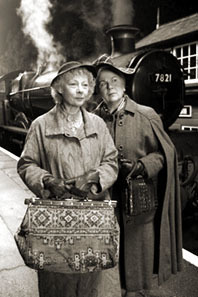 The countryside around Greenway is still quite rural, approached by Devon's famously narrow lanes, and in Agatha's day, when motorcars were few, it was a remote country haven indeed. The best way to get there would have been by the steam trains routes that once ran all across the West Country -- and in fact one of those trains remains, running down the coast from Paignton to Kingswear. Since these trains are such a feature of Agatha's fiction, that's how we decided to go.
The countryside around Greenway is still quite rural, approached by Devon's famously narrow lanes, and in Agatha's day, when motorcars were few, it was a remote country haven indeed. The best way to get there would have been by the steam trains routes that once ran all across the West Country -- and in fact one of those trains remains, running down the coast from Paignton to Kingswear. Since these trains are such a feature of Agatha's fiction, that's how we decided to go.
In addition to Victoria, we took along two of her friends: a trio of women now in their 20s who have known each other since childhood. I think of them as the Three Graces, for in intelligence, talent, and beauty (inner and outer) they could teach even those Greek goddesses a thing or two -- but they will appear today only in this acknowledgement of their lovely presence on our journey, as I don't want to infringe on their privacy by posting their pictures without permission.
When we left the house, it was autumn on Dartmoor, but the season shifted back to late summer as we drove south to Paignton...and then time itself shifted as we boarded the train, taking us back to the 1930s. One of my dresses happens to be from that era (bought years ago at a vintage shop), so I wore it that day in Agatha's honor and imagined our party as characters in her books...preferably without the murderer or murder victim in our midst.
The train runs along the edges of the Torbay coastline, so the views are rather spectacular, and the steam trailing past and the hooting of the whistle seem familiar from so many old films...
The train makes a stop at Greenway Halt in the valley below the Greenway estate. Howard and the Graces exited there, then continued on foot through the Greenway woods -- but, alas, I was walking with a cane that day, so I caught the decidedly less romantic shuttle-bus instead. I'd read Janet Morgan's biography of Agatha just the week before, so I thought about her remarkable life as I made my own up to the house. I imagined her beside me, with her much-loved dogs, walking and talking with the formidable energy she sustained into old age...and since this was my daydream, I was hale and hearty, walking just energetically too.
Dame Agatha Mary Clarissa Christie, n��e Miller, came from a privileged background (her father had inherited a fortune) and was raised in a large house in Torquay, a seaside town more elegant and exclusive in her day than it is in ours. Although a large portion of the money was gone by the time her father died when Agatha was 12, she was nonetheless used to a world of large houses, servants, and friends with titles before their names...a world she would later portray (and dissect) so well in her various books. She was a shy, quiet girl who loved animals, music, and the Devon countryside; she loved to swim (and did so all her life) and to tramp across the wilds of Dartmoor. She never had a formal education (and barely any schooling at all), a fact that somewhat embarrassed her. Instead, she educated herself by reading her way through her father's library, and then trained as a pharmacist as part of the war effort during the years of World War I. (This gave her a useful understanding of toxic substances!)
Agatha left her beloved Devon for London during her first marriage to Archie Christie, a pilot and war hero -- but the marriage ended abruptly and traumatically when their only child, Rosalind, was seven. Agatha's mother had contracted an illness and died, and while Agatha reeled from this sudden loss, Archie announced he was in love with someone else and wanted a divorce. Divorce was still uncommon then, so this involved public scandal as well as heart-break. In a state of shock from both of these blows, Agatha disappeared for ten dramatic days following a mental breakdown in which she'd lost all memory of who she was. Since she was already a popular novelist at this point, the newspapers went wild over her disappearance -- even going so far as to speculate that the whole thing was a publicity stunt, although this intrusively personal publicity was precisely the kind she loathed.
Agatha's second marriage, to archaeologist Max Mallowan, was a much happier one. She'd been very young when she married Archie Christie on the eve of World War I (a time of many over-hasty marriages), and in Max, she'd found a partner who was considerably more compatible: intellectual, adventurous, and interested in everything, just like Agatha. (Archie, by contrast, was a stockbroker whose only real passion was playing golf. He left Agatha for a fellow golfer.)
Agatha and Max met on an archaeological dig in southern Iraq: she was there by invitation (a friend was running the dig); he was a member of the working team. She was 39 years old and already famous; he was 26 and at the start of his career. This unlikely couple fell in love while sharing a harrowing train-and-boat journey back to England, married later that year, then forged a long and successful life together -- divided between periods in Oxford (where he taught), London (where she wrote for the theatre), summers with Rosalind and her family at Greenway, and winters at Max's archaeological digs in the deserts of Syria and Iraq. (Agatha could work anywhere, and simply took her typewriter along.) He went on to become as well regarded in his field as she was in hers, and received a knighthood for it.
Max and Agatha bought Greenway in 1938. "���One day we saw that a house was up for sale that I had known when I was young," Agatha wrote in her autobiography. "So we went over to Greenway, and very beautiful the house and grounds were. A white Georgian house of about 1780 or 90, with woods sweeping down to the Dart below, and a lot of fine shrubs and trees -- the ideal house, a dream house...."
Although they didn't live there year-round, Greenway was always bustling with life: Rosalind and her family spent a great deal of time there, family friends were urged to go and stay (Agatha had always been generous this way), and the staff was encouraged to make use of the whole house whenever the family wasn't around. Agatha often said that Greenway was her true home.
Agatha died at the age of 86, world famous, much loved, and with her family around her. Max died two years later, and the Greenway estate was passed down to Rosalind and her son. They, in turn, passed the house and all its contents to the National Trust, under strict conditions: It was not to be turned into a commercial "Agatha Christie theme park," but left to look just as it did when Agatha lived and worked there -- the same books on the shelves, the same art on the walls, the same dishes in the cupboards of its large country kitchen, the same black typewriting poised on the desk, ready for her next story
Although grand from the outside, when you step through Greenway's door it doesn't feel like a show piece; it still feels like a warm, cluttered, book-filled family home...albeit the home of an unusually well-traveled family, stuffed with curios and artifacts gathered from all around the word.
Despite Greenway's spaciousness, Agatha's office is squeezed into an endearingly small room...although in fact she wrote all over house: in the library, in the corner of the bedroom, in the living room amid the tumult of family life.
One of the things I admire about her is that she wasn't precious about her writing. She took it seriously (and expected others to do so too), yet she was always a consummate professional: she simply sat down and worked -- in trains, on boats, in hotel rooms, in tents under the Middle Eastern stars. Wherever she was, she observed life around her, took it all in, and then sat down and turned it into stories.
"There was a moment when I changed from an amateur to a professional," she wrote in her autobiography. "I assumed the burden of a profession, which is to write even when you don't want to, don't much like what you're writing, and aren't writing particularly well."
But she always wrote well, at least until the final years when her powers began to fail -- and even then, she concocted characters and plots so vivid that even her lesser works are engaging, suspenseful, and well worth reading.
After wandering through the house, Howard and I found a bench outside and sat in the warmth of the lowering sun, while from the house we could hear the faint notes of someone playing Agatha's piano. We wondered aloud what it would be like to live and work in place so peaceful, so beautiful....
And then we remembered that we do. Okay, ours is a plain little house, a simple, sturdy workman's dwelling from the Edwardian era, so small that the entire thing could probably fit into Agatha's living room. But we, too, are surrounded by the green beauty of Devon; and we, too, step through the door into a warm, cluttered, book-filled family home...albeit a much more humble one.
And suddenly we were eager to head back there. We gathered the Graces, and made for the train.
 Photographs are identified in the picture captions. (Run your cursor over the images to see them.) The majority of the photographs are mine, but when they're not, credits are listed. A related previous post: "On Poirot and the Pup" (2012).
Photographs are identified in the picture captions. (Run your cursor over the images to see them.) The majority of the photographs are mine, but when they're not, credits are listed. A related previous post: "On Poirot and the Pup" (2012).
November 3, 2015
Myth & Moor update
No post today, due to...well, due to the overwhelmingness of life. I'll be back tomorrow with that promised "steam train" post. In the meantime: here are some supple deer to teach us all we need to know.
The art above is "The Hind of the Forest" by Warwick Goble (1862-1943).
November 1, 2015
Tunes for a Monday Morning
I'm in the mood for a little John Dowland this morning, so I hope you are too....
Above, Dowland's "A Fancy," performed by the great English lutenist Julian Bream, the very best of Dowland's contemporary interpreters. His classic album Lute Music of John Dowland, recorded in a Dorset chapel in 1976, introduced many people to Dowland's compositions, and to Early Music in general.
Below, Dowland's "Lachrimae Pavan," performed on the classical guitar by Nataly Makovskaya. The piece was composed sometime before 1596 for solo lute, and then re-appeared as a song, "Flow My Tears," in Dowland's Second Booke of Songs or Ayres (1600). This guitar version is perfectly lovely.
Above, "Weep You No More Sad Fountains," from Dowland's Third and Last Booke of Songes or Ayres, 1603 -- which, fortunately, wasn't his last at all. The song is performed by the English folk & Early Music duo Ben Walker and Josienne Clarke, whose CDs I've been listening to so much lately that they've become the soundtrack of my summer and autumn. The folk end of their repertoire was featured here earlier this year, and also back in 2013.
Below, "Now, O Now I Needs Must Part" from Dowland's First Book Of Songs Or Ayres, 1597 -- performed by Les Canards Chantants, a choral group from America dedicated to Renaissance polyphony. Although they're based in Philadelphia, the video was filmed on a steam train on the North Yorkshire Moors Railway in the north of England. They say: "See if you can spot the station used as 'Hogsmeade' in the Harry Potter movie. All aboard the Hogwarts Express!"
As it happens, I've been on a steam train recently too, one that runs along the south Devon coast between Paignton and Kingswear. I'll tell you more about that tomorrow....
October 30, 2015
Happy Halloween from all of us at Bumblehill
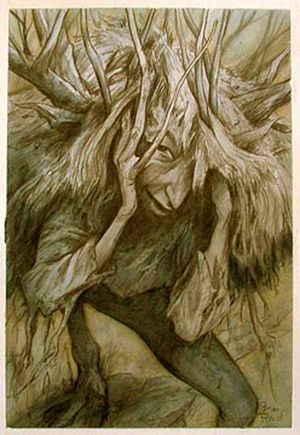 Here's some Halloween reading, in case you missed any of it the first time around:
Here's some Halloween reading, in case you missed any of it the first time around:
"At the Death of the Year," the folklore of Halloween, Samhain, and the Days of the Dead
On Tucson's "Day of the Dead," by Stu Jenks
"The Mouse in the House," on elusive mice and Halloweens past
"Witches in Children's Literature" by Katherine Langrish (on her Seven Miles of Steel Thistles blog): Part I, Part II, Witch Queens & Crones, and Good Witches.
And some Halloween listening:
"Phantasmagoria: Folk songs of ghosts, spirits, and hauntings" by Tamsin Rosewell.
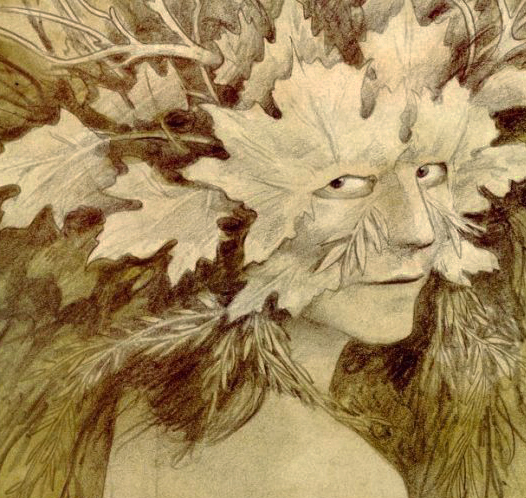 The art above is by my friend & neighbor Brian Froud; the titles are in the picture captions. His most recent books, co-created with writer & sculptor Wendy Froud, are Trolls and Faeries' Tales.
The art above is by my friend & neighbor Brian Froud; the titles are in the picture captions. His most recent books, co-created with writer & sculptor Wendy Froud, are Trolls and Faeries' Tales.
Following the hare...
Today I have another folklore post for you in the run-up to Halloween. This time it's on the subject of "Witch Hares," a creature more common that you might think....
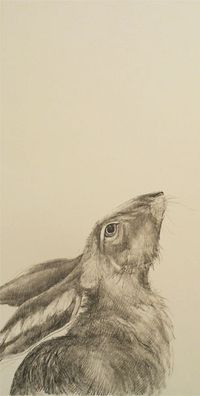 As Carolyne Larrington observes in her new book, The Land of the Green Men: A Journey Through the Supernatural Landscape of the British Isles: "We tend to associate witches with black cats that operate as their familiar spirits, but more traditionally the witch transforms herself into a hare in order to steal milk from the neighbours' cows. The witch-hare has other moneymaking sidelines, however: in one rather jolly tale from Tavistock in Devon, she gives the hare hunters a run for their money. In a letter written in 1833, a certain Mrs. Bray relates how a young boy would would earn money by starting hares for the local hare hunters -- he was always able to find one when they seemed scarce. Somehow, the hare always managed to get away. This made the huntsman suspicious, so on one occasion the hounds were teed up to to get on to their prey's trail more quickly. The hare zigged and zagged to cries from the boy of 'Granny! Quick! Run for your life!' Aha! The hare just made it into the boy's grandmother's cottage through a little hole. When the huntsmen broke in, no animal was to be seen. But the old woman was quite out of breath, and she had scratches as if she had been running through brambles."
As Carolyne Larrington observes in her new book, The Land of the Green Men: A Journey Through the Supernatural Landscape of the British Isles: "We tend to associate witches with black cats that operate as their familiar spirits, but more traditionally the witch transforms herself into a hare in order to steal milk from the neighbours' cows. The witch-hare has other moneymaking sidelines, however: in one rather jolly tale from Tavistock in Devon, she gives the hare hunters a run for their money. In a letter written in 1833, a certain Mrs. Bray relates how a young boy would would earn money by starting hares for the local hare hunters -- he was always able to find one when they seemed scarce. Somehow, the hare always managed to get away. This made the huntsman suspicious, so on one occasion the hounds were teed up to to get on to their prey's trail more quickly. The hare zigged and zagged to cries from the boy of 'Granny! Quick! Run for your life!' Aha! The hare just made it into the boy's grandmother's cottage through a little hole. When the huntsmen broke in, no animal was to be seen. But the old woman was quite out of breath, and she had scratches as if she had been running through brambles."
Why, asks Larrington, are there so many stories of witches in the shape of hares all across the British Isles?
"They were familiar animals before the industrialisation of the countryside," she notes, "and their habit of rearing up on their hind legs and their distinctive zigzag run made them easy to pick out. They are swift and clever -- which explains how they always manage to get back to the witches' houses before they 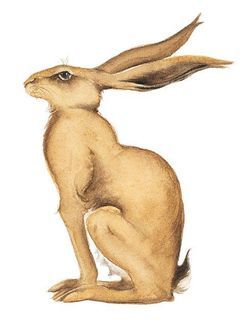 are caught -- and the have long been indigenous to the British landscape. Hares thus appear in a good deal of folklore across the country....I've seen hares myself near where I live in North Oxfordshire, up by the Roman road that runs along the southern side of Madmarston Hill near Swalcliffe: two big beasts on their hind legs, boxing away at one another like a couple of prizefighters, until they spotted me and the dog. Then they swerved away over the stubbly March fields, only to take up their bout again at a more distant corner. These hares were probably a male/female pair, rather than rival males duking it out: the female was trying the repel the male's advances, with limited success."
are caught -- and the have long been indigenous to the British landscape. Hares thus appear in a good deal of folklore across the country....I've seen hares myself near where I live in North Oxfordshire, up by the Roman road that runs along the southern side of Madmarston Hill near Swalcliffe: two big beasts on their hind legs, boxing away at one another like a couple of prizefighters, until they spotted me and the dog. Then they swerved away over the stubbly March fields, only to take up their bout again at a more distant corner. These hares were probably a male/female pair, rather than rival males duking it out: the female was trying the repel the male's advances, with limited success."
Hares are sometimes seen to gather together in what looks like a convocation, says Larrington, "eight or ten of them sitting in a circle and gazing at one another as if in silent communication. The writer Justine Picardi mentions seeing just such a phenomenon in June 2012 in the Scottish highlands:
" 'On the way here last night, a magical scene: glimpsed in a field beside the lane, a circle of hares, all gazing inward, motionless in the moment that we passed. I've heard occasional stories of these rarely witnessed gatherings -- but never seen one for myself. No camera to hand -- although if we'd stopped, I'm sure the hares would have vanished -- yet a sight impossible to forget.'
"But we know of course that these were no ordinary hares, but surely a gathering of witches in hare form."
If you'd like to know more about about Witch Hares and other hare legends, then in addition to Larrington's book (which devotes part of a chapter to the subject), I recommend The Leaping Hare by George Ewart Evans & David Thomson, a volume completely devoted to hare history and legendry. Another one to seek out is The Hare Book, edited by Jane Russ for The Hare Preservation Trust (UK), which is a delightful and informative compilation of stories and facts about hares accompanied by photographs and art -- including contributions from Jackie Morris, Virginia Lee, and Hannah Willow. (I particularly recommend Jackie's story in the book, "The Old Hare in Spring: 1502," inspired by the art of Albrecht D��rer, and the charming true-life tale of the three hares beloved by the 18th century poet William Cowper.)
You'll find more magical hares in my previous post "The Folklore of Rabbits and Hares" -- as well as some Witch Hares leaping through a post on Devon folklore: "Tales of a Half-Tamed Land." Devon is a veritable hotbed of shape-shifting hares, so be wary if you're out after dark here....
The gorgeous hare art in this post is by Jackie Morris, one of the finest painters of hares (and other animals) working today. After admiring her art and stories for years, I finally had the opportunity to meet her earlier this month when her travels brought her through Devon -- and to see her gorgeous new book: The Wild Swans (which I highly recommend), and to hear about her current project: a collaboration with Robert Macfarlane. (What a combination of talents that will be!) To view more of Jackie's work, please visit her website and seek out her beautiful books...especially, in light of today's subject, Song of the Golden Hare.
 The quote by Carolyne Larrington is from The Land of the Green Men (I.B.Taurus & Co., 2015). The quotes in the picture captions are from The Hare Book edited by Jane Russ (The Hare Preservation Trust/ Graffeg Books, 2014). All rights to the text and art above reserved by their respective creators. A previous post on Jackie Morris' marvelous books: "The wild sky."
The quote by Carolyne Larrington is from The Land of the Green Men (I.B.Taurus & Co., 2015). The quotes in the picture captions are from The Hare Book edited by Jane Russ (The Hare Preservation Trust/ Graffeg Books, 2014). All rights to the text and art above reserved by their respective creators. A previous post on Jackie Morris' marvelous books: "The wild sky."
Terri Windling's Blog
- Terri Windling's profile
- 708 followers



